
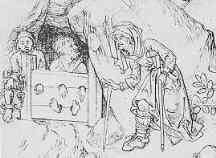


Stocks had become common in England by the mid-14th century. In 1351 a law (the Statute of Labourers) was introduced requiring every town to provide and maintain a set of stocks. This had been implemented as a reaction to the Black Death, which had halved the population. The consequent scarcity of labour had enabled agricultural labourers to demand increased pay. The Statute attempted to discourage this trend by providing that anyone demanding (or offering) higher wages should be set in the stocks for up to 3 days.
Stocks were later used to control the unemployed. A statute passed in 1495 required that vagabonds should be set in the stocks for 3 days on bread and water and then sent away (where presumably they would have faced a similar fate). If a vagabond returned to the same parish, he or she would receive another 6 days in the stocks. These punishments were however seen as excessive and the lengths of time in the stocks were later reduced to 1 and 3 days respectively.
A Statute of 1605 required that anyone convicted of drunkenness should receive six hours in the stocks, and those convicted of being a drunkard (as opposed to be caught drunk) should suffer 4 hours in the stocks or pay a substantial fine (of 3 shillings and 6 pence). A slightly later Statute made it legal to set those caught swearing in the stocks for 1 hour, if they could or would not pay a 12 pence fine. In practice the authorities preferred offenders to pay fines as the monies were used to fund poor relief.
Here are some more historical illustrations:


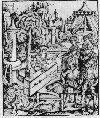


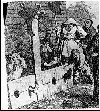



Most European countries abolished stocks and pillories by the
middle of the 19th century, as did most American states. Except
for Delaware, which was reluctant to abandon the pillory until
1905.

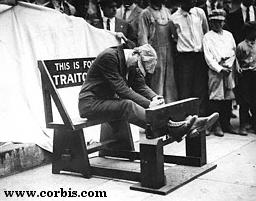
In England, the pillory was abolished in 1837. This is a scan of the original Act of Parliament:
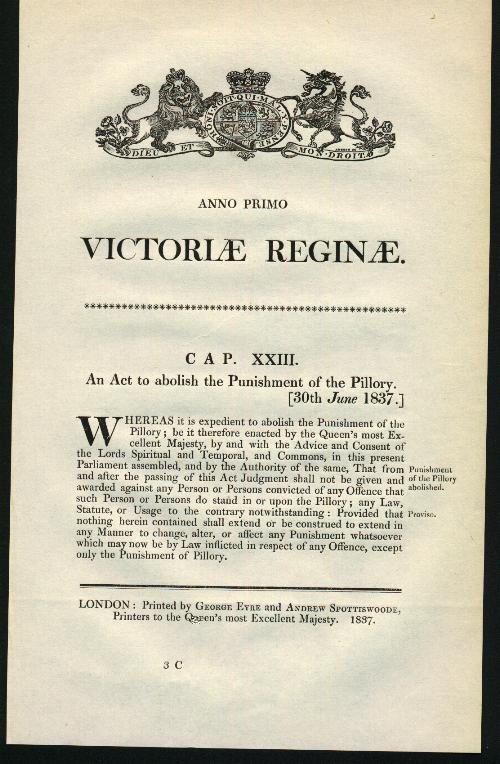
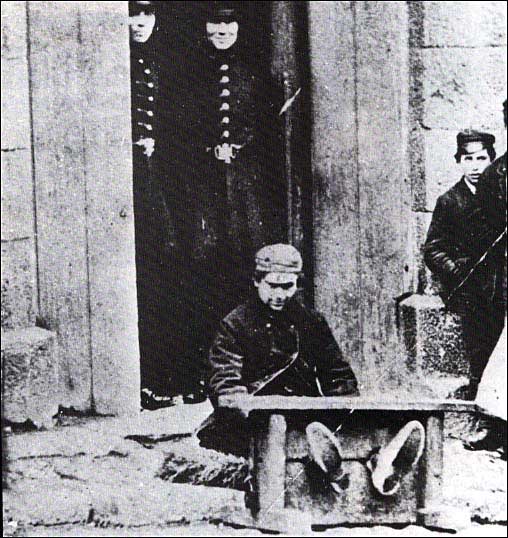
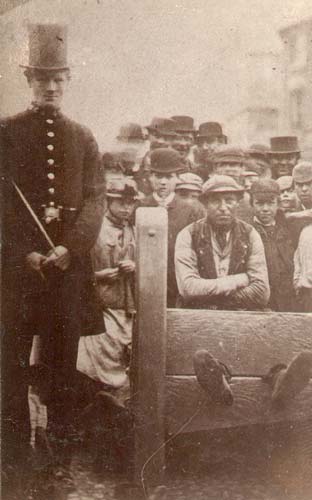 Curiously enough, the
stocks were never formally abolished. They continued to be used, albeit
less
regularly, until the 1870s. One of the more recent cases on record was
reported in the Leeds Mercury (14 April 1860). At Pudsey, the
appropriately
named John Gambles sat in the stocks for six hours for gambling on a
Sunday.
Curiously enough, the
stocks were never formally abolished. They continued to be used, albeit
less
regularly, until the 1870s. One of the more recent cases on record was
reported in the Leeds Mercury (14 April 1860). At Pudsey, the
appropriately
named John Gambles sat in the stocks for six hours for gambling on a
Sunday.
Another case involved drunkenness. In 1865 William Jarvis (see left photo) sat in the stocks in Rugby for six hours for insobriety.
The last recorded instance of the stocks being used in England was in Newbury in 1872. According to a contemporary account, �Mark Tuck, a rag and bone dealer, who for several years had been well known as a man of intemperate habits, and upon whom imprisonment in Reading gaol had failed to produce any beneficial effect, was fixed in the stocks for drunkenness and
disorderly conduct in the parish Church on Monday evening. Twenty-six years had elapsed since the stocks were last used, and their reappearance created no little sensation and amusement, several hundreds of persons being attracted to the spot where they were fixed. Tuck was seated upon a stool, and his legs were secured in the stocks at a few minutes past one o�clock, and as the church clock, immediately facing him, chimed each quarter, he uttered expressions of thankfulness, and seemed anything but pleased at the laughter and derision of the crowd. Four hours having passed, Tuck was released, and by a little stratagem on the part of the police, he escaped without being interfered with by the crowd.�
Although stocks and pillories fell into disuse in Europe in the mid-19th century, they continued to be used as a judicial punishment in other countries.
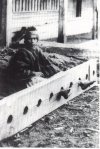
A man in the stocks in Chile.
|

Prisoners in Persia (now Iran).
|

Two men pilloried in the Philipines in 1899.
|

Prisoner in Ceylon (now Sri Lanka).
|
"Authorities on Panama's western coast, in a practice recalling the Middle Ages, have brought back the wooden pillory to punish rebellious native peoples, a local humanitarian group has charged.
Activists of Catholic group Service of Peace and Justice (Serpaj) showed photographs of an improvised pillory used to hold indigenous men, women and children accused of breaking the law. The pillory was constructed of two wooden boards with openings in the shape of a half moon. It is used to immobilize a person by his neck, feet or arms.
Jose Mendoza, coordinator of Serpaj, told IPS that they have already identified four locations where local officials are using this medieval punishment device to imprison accused lawbreakers by their feet.
Mendoza said that Serpaj activists confirmed the use of pillories in Chorcha in the district of San Felix, in Cerro Iglesia, the districts of Remedios and in Cerro Puerco, and in the district of Tole -- all located in the western province of Chiriqui, bordering Costa Rica. Pillories were also set up in El Prado, district of Las Palmas of the same province, he added.
Victims of this punishment are the Ngobe-Bugle indigenous
people. For the last 20 years they have been locked in dispute
with the government for the return of some 11,000 sq kms of
territory located in Chiriqui and in the western provinces of
Veraguas and Bocas del Toro."
